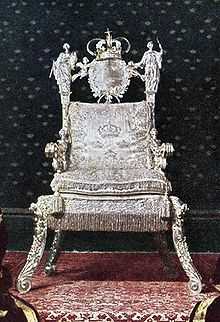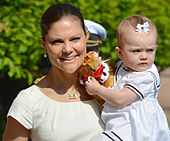Line of succession to the Swedish throne


The line of succession to the Swedish throne is determined by the Act of Succession (Swedish: Successionsordningen), originally approved jointly by the Riksdag of the Estates assembled in Örebro and King Charles XIII in 1810.[1][2]
In 1979, the Riksdag introduced absolute primogeniture, meaning that the eldest child of the monarch, regardless of gender, is first in the line of succession. The change entered into force on 1 January 1980,[3][4] making Sweden the first country to adopt absolute primogeniture.[5] The Swedish crown had previously (since 1810) descended according to agnatic primogeniture, meaning that only males could inherit it.[6]
Line of succession
 King Carl XVI Gustaf (born 1946)[3]
King Carl XVI Gustaf (born 1946)[3]
- (1) Crown Princess Victoria, Duchess of Västergötland (b. 1977)[4]
- (2) Princess Estelle, Duchess of Östergötland (b. 2012)[7]
- (3) Prince Carl Philip, Duke of Värmland (b. 1979)[8]
- (4) Princess Madeleine, Duchess of Hälsingland and Gästrikland (b. 1982)[9]
- (5) Princess Leonore, Duchess of Gotland (b. 2014)[10]
- (1) Crown Princess Victoria, Duchess of Västergötland (b. 1977)[4]
Eligibility
According to the Act of Succession, only King Carl XVI Gustaf's Lutheran legitimate descendants brought up in Sweden are presently entitled to succeed.[6][11] A person loses his or her succession rights and deprives his or her descendants of their succession rights if he or she:
- is not brought up in Sweden[11]
- ceases to be a Lutheran (Article 4)[6][11]
- marries without the consent of the Government (Article 5)[6][11] or
- ascends the throne of another state by election, inheritance or marriage without the consent of the monarch and the Riksdag (Article 8)[6][11]
See also
References
- ↑ "Act of Succession". The Riksdag. Retrieved 2014-01-29.
- ↑ "Successionsordning (1810:0926)" (in Swedish). The Riksdag. Retrieved 2014-01-29.
- ↑ 3.0 3.1 "H.M. King Carl XVI Gustaf - Biography". www.kungahuset.se. Swedish Royal Court. Retrieved 22 December 2013.
King Carl Gustaf and Queen Silvia have three children: Crown Princess Victoria, born on 14 July 1977, Prince Carl Philip, born on 13 May 1979 and Princess Madeleine, born on 10 June 1982. Under the Order of Succession introduced in 1980 by the Swedish Parliament, the throne passes to the eldest child.
- ↑ 4.0 4.1 "H.R.H. Crown Princess Victoria - Biography". www.kungahuset.se. Swedish Royal Court. Retrieved 22 December 2013.
In accordance with the 1979 Act of Succession, which entered into force on 1 January 1980, Crown Princess Victoria is heir to the Swedish throne.
- ↑ "Duties of the Monarch". www.kungahuset.se. Swedish Royal Court. Retrieved 22 December 2013.
By this principle, which Sweden is the first country to have introduced, the throne passes to the eldest child, whether male or female.
- ↑ 6.0 6.1 6.2 6.3 6.4 Constitutional Law in Sweden. Kluwer Law Internationa. 2011. pp. 42–44. ISBN 9041134352. Retrieved 22 December 2013.
Thus, no freedom of religion exists for the royal family.
- ↑ "H.R.H. Princess Estelle - Biography". www.kungahuset.se. Swedish Royal Court. Retrieved 22 December 2013.
Princess Estelle is second in the line of succession, following Crown Princess Victoria.
- ↑ "H.R.H. Prince Carl Philip - Biography". www.kungahuset.se. Swedish Royal Court. Retrieved 22 December 2013.
Prince Carl Philip is third in line of succession, after Crown Princess Victoria and Princess Estelle.
- ↑ "H.R.H. Princess Madeleine - Biography". www.kungahuset.se. Swedish Royal Court. Retrieved 22 December 2013.
Princess Madeleine is fourth in the line of succession, following Crown Princess Victoria, Princess Estelle and Prince Carl Philip.
- ↑ "H.R.H. Princess Leonore - Biography". www.kungahuset.se. Swedish Royal Court. Retrieved 13 June 2014.
In accordance with the 1979 Act of Succession, which entered into force on 1 January 1980, Princess Leonore is fifth in the line of succession, following Princess Madeleine.
- ↑ 11.0 11.1 11.2 11.3 11.4 "The Act of Succession". www.legislationline.org. Retrieved 22 December 2013.
The right of succession to the throne of Sweden is vested in the male and female descendants of King Carl XVI Gustaf's ... issue in direct line of descent. In this connection, older siblings and their descendants have precedence over younger siblings and their descendants... The King shall always profess the pure evangelical faith, as adopted and explained in the unaltered Confession of Augsburg and in the Resolution of the Uppsala Meeting of the year 1593, princes and princesses of the Royal House shall be brought up in that same faith and within the Realm. Any member of the Royal Family not professing this faith shall be excluded from all rights of succession... A prince or princess of the Royal House may not marry unless the Government has given its consent thereto upon an application from The King. Should a prince or princess marry without such consent, that prince or princess forfeits the right of succession for himself, his children and their descendants... A prince or princess of the Swedish Royal House may not become the sovereign ruler of a foreign state whether by election, succession, or marriage without the consent of The King and the Riksdag. Should this occur, neither he nor she nor their descendants shall be entitled to succeed to the throne of Sweden.
| ||||||||||